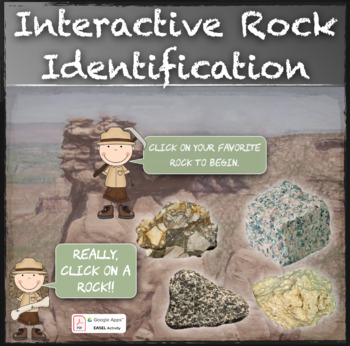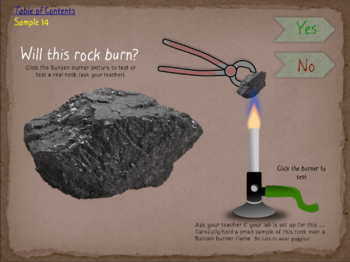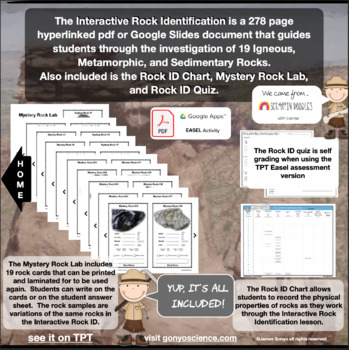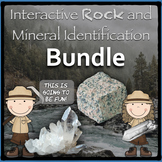Interactive Rock Identification / Distance Learning
- Zip
- Google Apps™
- Easel Activity
- Easel Assessment

What educators are saying
Also included in
- The Interactive Mineral Identification and Interactive Rock Identification are the perfect way to introduce basic properties of rocks and minerals to students in virtual, hybrid, or face to face classrooms. Get your students up and running faster than ever with the addition of Google Apps and TPT EaPrice $21.60Original Price $24.00Save $2.40
Description
In the Interactive Rock Identification is the perfect way to introduce basic properties of rocks to students in virtual, hybrid, or face to face classrooms. Get your students up and running faster than ever with the addition of Google Apps and TPT Easel formats. The traditional PDF version is also included along with a Quick Link that opens the lesson online right in the student’s browser. See the Preview above (in presentation mode) for a functional demonstration of the Interactive Rock ID.
This lesson includes:
Interactive Rock Identification (run online, interactive pdf, or Google Slides )
Rock ID Chart (pdf, Google Slides, TPT Easel)
Mystery Rock Lab (pdf, Google Slides, TPT Easel)
Rock ID Quiz (pdf, Google Slides, TPT Easel)
Answer keys
Archive folder (previous versions)
The Interactive Rock Identification is a 279 page hyperlinked pdf or Google Slides document that guides students through the investigation of 19 Igneous, Sedimentary, and Metamorphic rocks without the need for actual rock samples!
From the main menu, students choose rocks in any order. The Interactive Rock ID will navigate like a website with clickable links to move students along based upon their responses. When a student gives an incorrect response they are taken back to the beginning of the rock sample to try again. Information pages are just a click away for students to learn about rock texture, grain size, mineral content, layering, and more. Once a student correctly answers all questions for a rock, the rock’s identity is revealed along with a description of the rock’s physical properties, how it formed, its uses, and more.
In addition to the Interactive Rock ID is the Rock ID Chart, Mystery Rock Lab, and Rock ID Quiz activities. All activities come in PDF, Google Slides, and TPT Easel formats so you can choose which works best for you and your students.
Rock ID Chart is a chart for students to record rock properties as they work through the Interactive Rock ID. The Rock ID Chart can be printed or filled in digitally through Google Classroom or TPT Easel.
Mystery Rock Lab is a set of 19 cards each with a picture of a rock and a space to fill in the rock’s properties and name. The rock pictures show a different variety of each rock found in the Interactive Rock ID. The Mystery Rock Lab cards can be printed on card stock and laminated to be used again; an answer sheet is included for students to hand in. The Mystery Rock Lab can be printed or filled in digitally through Google Classroom or TPT Easel.
The Rock ID Quiz is a 12 question assessment from the information in the Interactive Rock ID. Teachers will decide if they want their students to use the interactive lesson or store all of those rocks in their head! The quiz can be printed or filled in digitally through Google Classroom or TPT Easel (the quiz is an Easel assessment so it will be automatically graded).
NOTE: previous versions of the Interactive Rock Identification are included in your TPT purchase in the “Archive” folder for those who prefer.
RELATED PRODUCTS:
Interactive Mineral Identification







